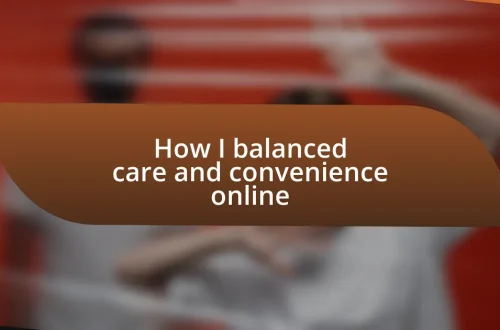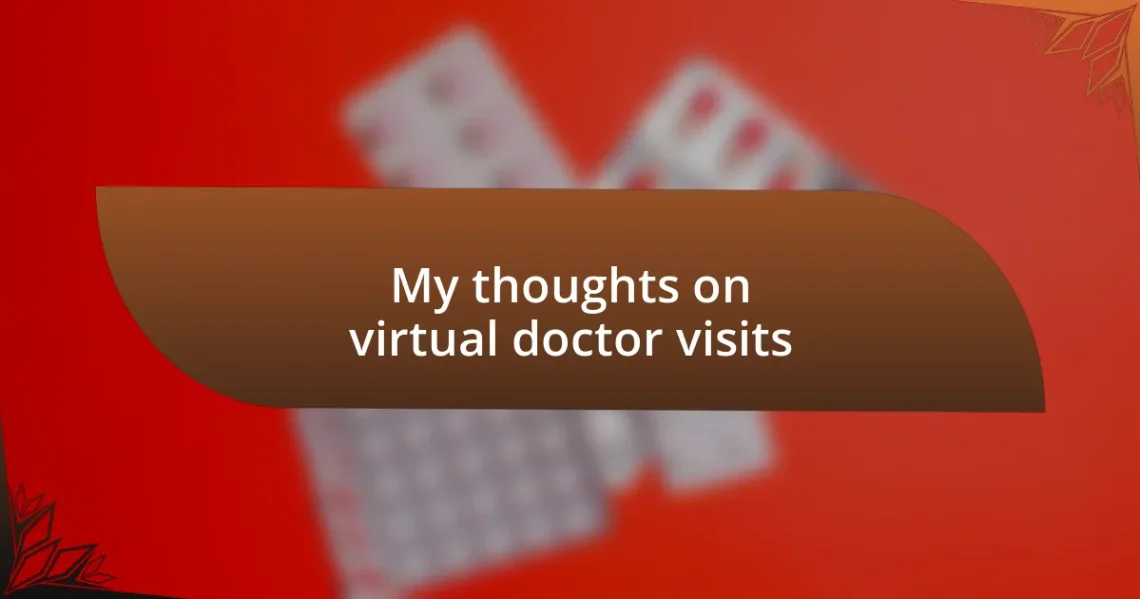
My thoughts on virtual doctor visits
Key takeaways:
- Virtual doctor visits offer convenience and enhance communication, allowing patients to engage more effectively in their healthcare.
- Challenges include limited physical examination, technical issues, and difficulty establishing personal connections, impacting patient satisfaction.
- Effective preparation, including testing technology and creating a list of concerns, improves the virtual appointment experience.
- The future of telemedicine promises personalized care with advanced technology, including AI and wearable devices, enhancing diagnostic accuracy and mental health services.
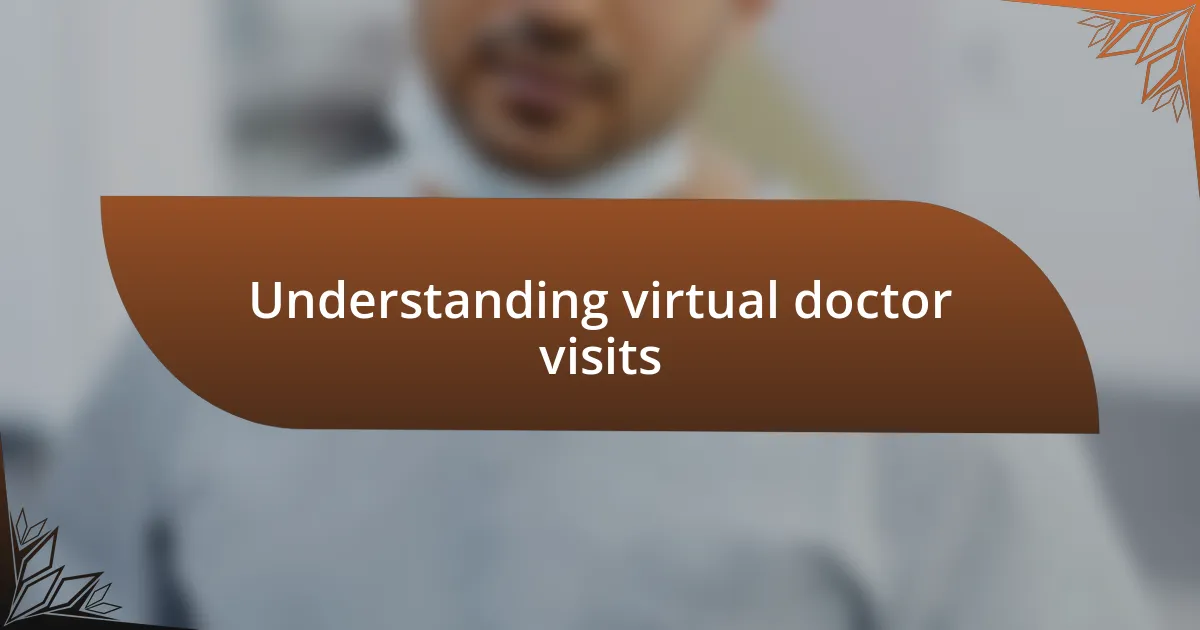
Understanding virtual doctor visits
Virtual doctor visits have truly transformed the way we approach healthcare. I remember my first experience with a telehealth appointment; I felt a mix of curiosity and apprehension. Would the doctor really understand my concerns through a screen? What I quickly realized, however, is that these visits can be just as effective as in-person consultations, provided you prepare adequately.
The convenience of accessing medical care without stepping out of your home is incredible. Imagine being able to discuss your health issues while sitting comfortably on your couch, free from waiting rooms and long drives. In my case, this saved me not just time, but the stress of navigating city traffic, which can often feel like an overwhelming obstacle in seeking care.
One aspect that stands out to me is the potential for enhanced communication. I found that, during my virtual visits, I could take notes or refer to my health records directly on my device, ensuring I didn’t miss anything the doctor said. Have you ever felt lost during a consultation? With virtual visits, I felt more empowered to ask questions and engage in discussion, which ultimately led to a clearer understanding of my health.
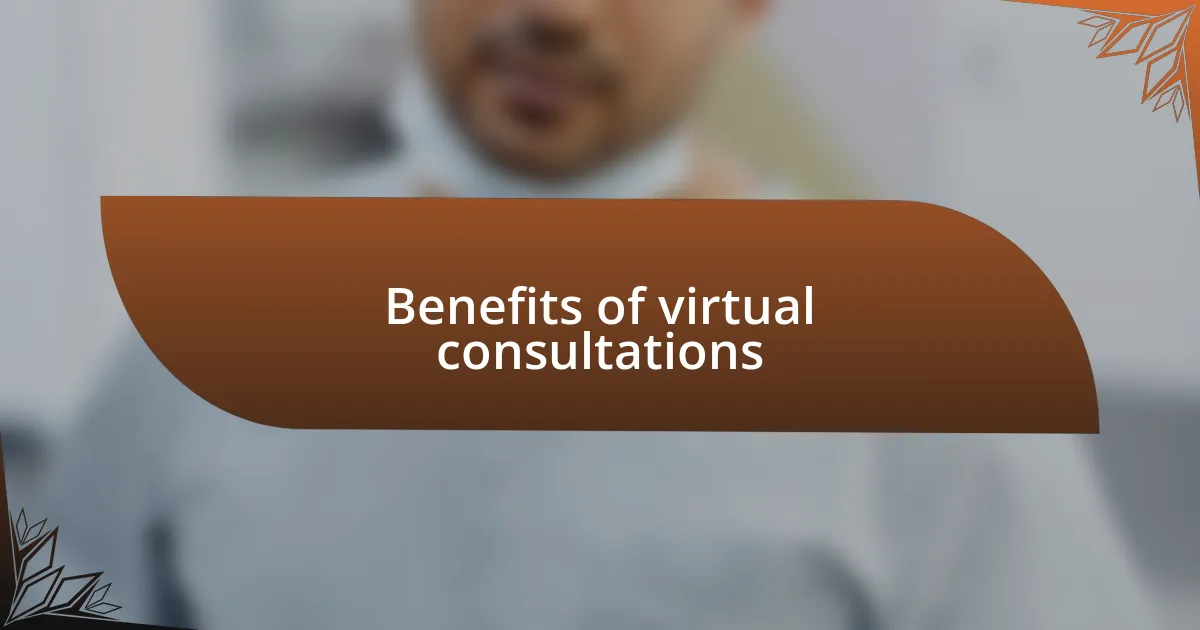
Benefits of virtual consultations
The benefits of virtual consultations are numerous and can significantly enhance the patient experience. I remember a day when I had a minor health concern but was stuck at work. Instead of delaying care, I scheduled a quick video call during my lunch break. This flexibility not only allowed me to address my issue promptly but also left me feeling productive and in control of my day.
Here are some key benefits of virtual consultations:
- Convenience: You can see your doctor from anywhere, eliminating the need for travel.
- Time-saving: Appointments can fit into your schedule, reducing wait times.
- Accessibility: Patients in remote areas can connect with specialists that may not be available locally.
- Comfort: Being in your own space can help ease anxiety during consultations.
- Continuity of care: Quick follow-ups and check-ins are simplified, ensuring ongoing support for chronic conditions.
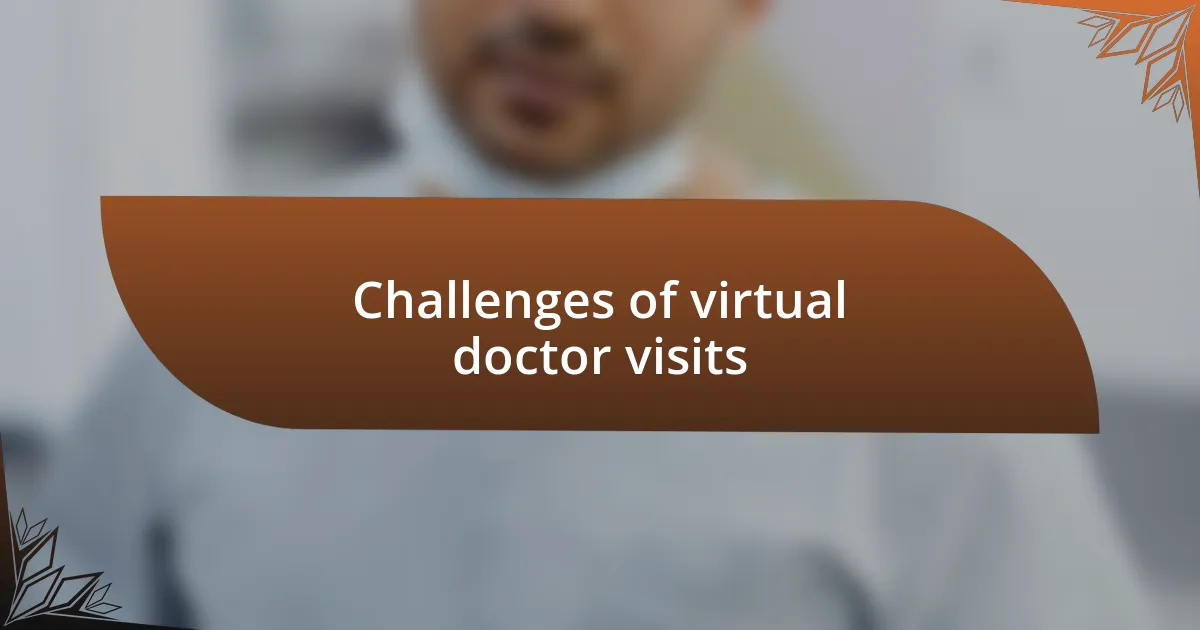
Challenges of virtual doctor visits
The challenges of virtual doctor visits can be quite significant, often impacting the overall experience for both patients and providers. For instance, the lack of physical examination limits the doctor’s ability to assess certain conditions accurately. I recall a time when I had a virtual check-up, and it felt frustrating not to have the doctor physically examine my throat, which left me wondering if key symptoms were being overlooked.
Technical issues can also create barriers during virtual visits. Imagine gearing up for an important appointment, only to find that your internet connection is spotty or the app crashes. I’ve been there, and that feeling of helplessness can add unnecessary stress to an already anxious situation.
Additionally, there’s the challenge of establishing a personal connection in a virtual format. I often found myself wishing for that eye contact and rapport that comes with in-person meetings. These intangible aspects of care are harder to replicate digitally, leaving some patients feeling less satisfied with their interactions.
| Challenge | Description |
|---|---|
| Limited Examination | Inability to perform physical assessments can hinder accurate diagnostics. |
| Technical Issues | Connectivity problems and software glitches can interrupt consultations. |
| Lack of Personal Connection | Building rapport feels more challenging without face-to-face interaction. |
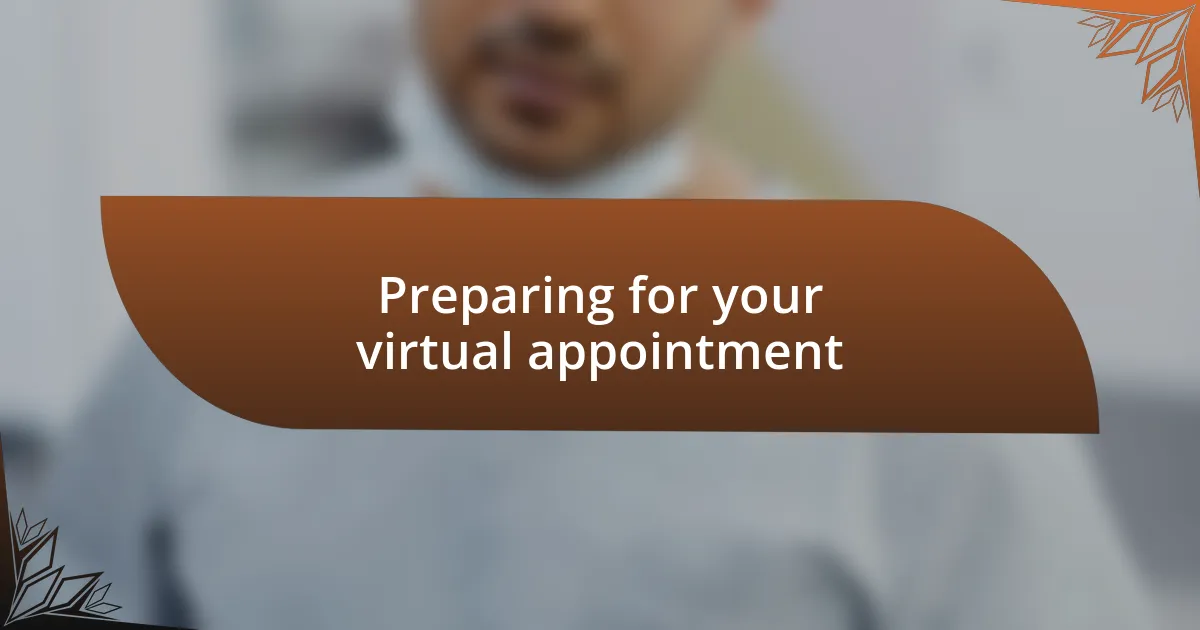
Preparing for your virtual appointment
Preparing for your virtual appointment requires a little organization. Before your scheduled time, I find it helpful to create a list of symptoms or questions you want to discuss. I once showed up to a virtual visit without any notes, and I completely blanked on key concerns. Having everything laid out ensures that you cover all the important points during the call.
Next, make sure your tech is ready to go. I can’t stress enough how crucial this is! There’s nothing worse than logging into a virtual appointment, only to realize your camera isn’t working or your microphone is muted. I’ve experienced that sinking feeling when I was excited to discuss a health issue, but technical hiccups got in the way. To avoid this, I recommend doing a quick test run with the technology beforehand.
Lastly, consider your surroundings. Choose a quiet, well-lit space where you feel comfortable and won’t be easily distracted. I remember once attempting to have an appointment in a busy café, thinking it would work fine. However, background noise and interruptions made it nearly impossible to focus. Your environment can significantly impact the quality of the consultation, so find a peaceful spot where you can concentrate fully.
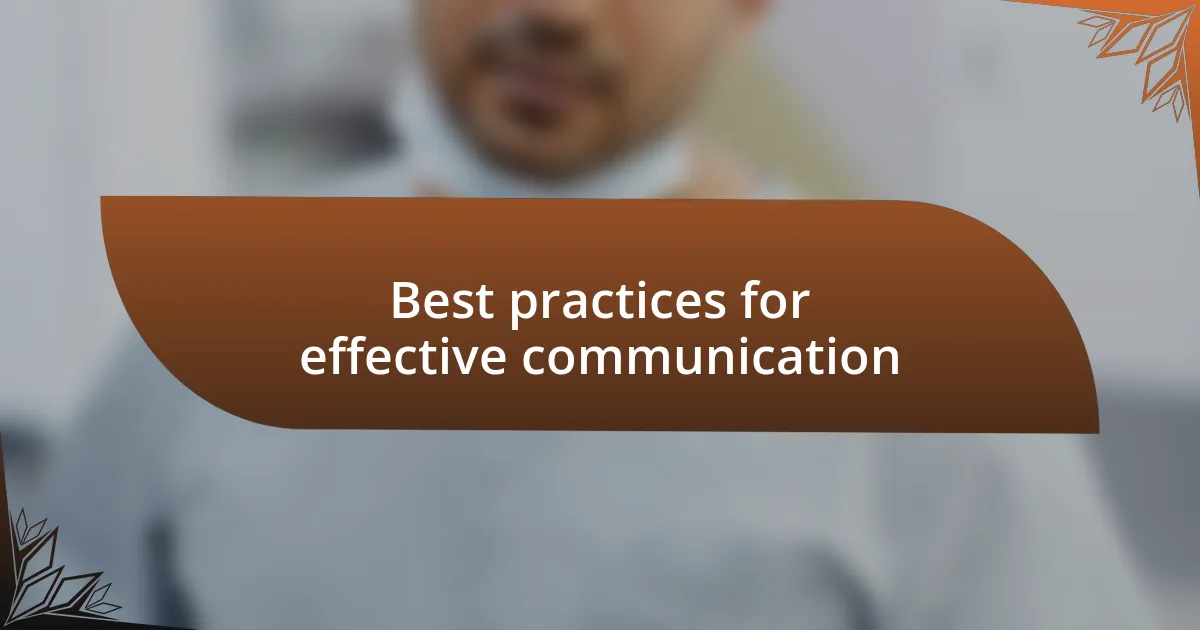
Best practices for effective communication
Effective communication during a virtual doctor visit is essential for getting the most out of your appointment. I’ve noticed that speaking clearly and at a moderate pace really helps me convey my concerns better. When I rushed through my symptoms in a previous appointment, the doctor seemed lost, which made me feel frustrated. I now remind myself to slow down and make sure each point is understood.
Another key point I’ve learned is the importance of active listening. During one of my visits, I realized how engaging with my doctor helped build a better rapport. I made a conscious effort to nod and respond to their questions, which created a dialogue rather than a monologue. Are you listening as intently as you’re speaking? I find that seeking clarification on anything I don’t understand gives me the confidence to participate fully in my healthcare.
Finally, don’t hesitate to express your feelings about what you’re going through. I once shared with my doctor how anxious I felt about my symptoms, and it changed the entire tone of the conversation. It opened up room for a discussion about mental well-being alongside physical health, making me feel more supported. Remember, your doctor can’t read your mind—sharing your emotions can lead to a more empathetic and effective consultation.
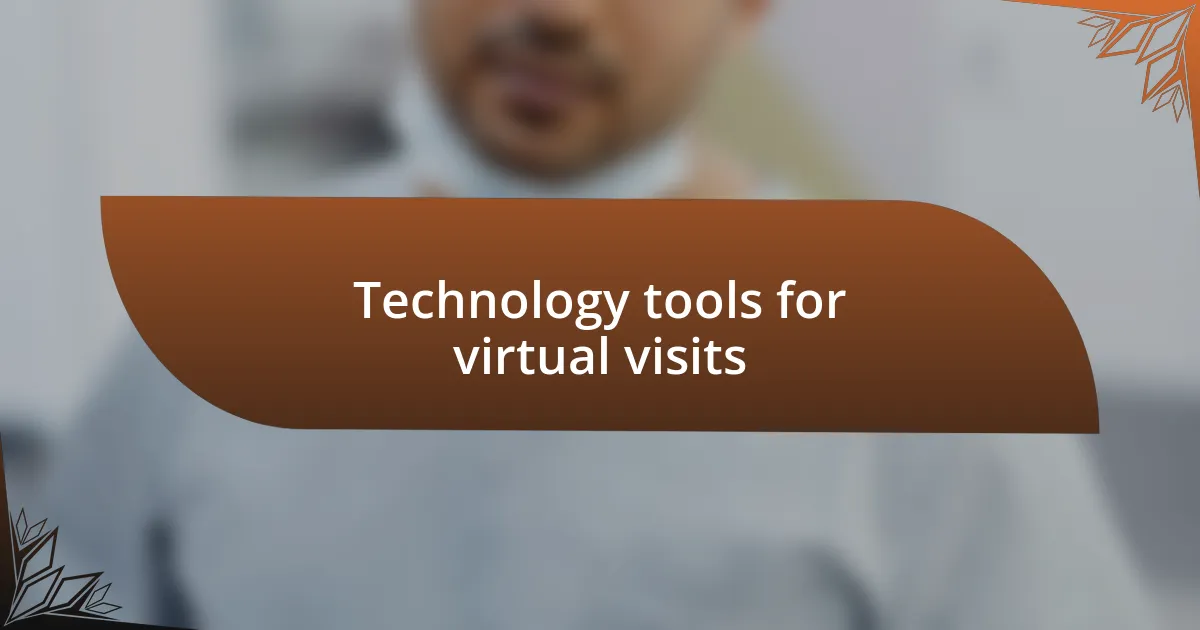
Technology tools for virtual visits
To make virtual doctor visits successful, the right technology tools are crucial. I often rely on platforms like Zoom or Doxy.me, which are designed specifically for healthcare. These tools not only offer a secure connection but also come packed with features like screen sharing. Have you ever thought how helpful it is to show your doctor a rash or a specific injury? It makes the consultation so much more effective.
I’ve also learned the importance of having a reliable device and internet connection. Early on, I encountered issues with buffering during a consultation—I felt like I was losing important details. Now, I make sure my Wi-Fi is strong and that I’m using a device that can handle the video calls. It’s a small step, but it leads to a much smoother experience.
Furthermore, I can’t stress enough the value of using health apps that integrate with virtual visits. I remember discovering a medication management app that helped me track my prescriptions better. It not only reminded me of doses but also presented my medication history right when I needed it during visits. How streamlined is that? This kind of preparation allowed me to have more productive conversations with my doctor, ensuring no detail slipped through the cracks.
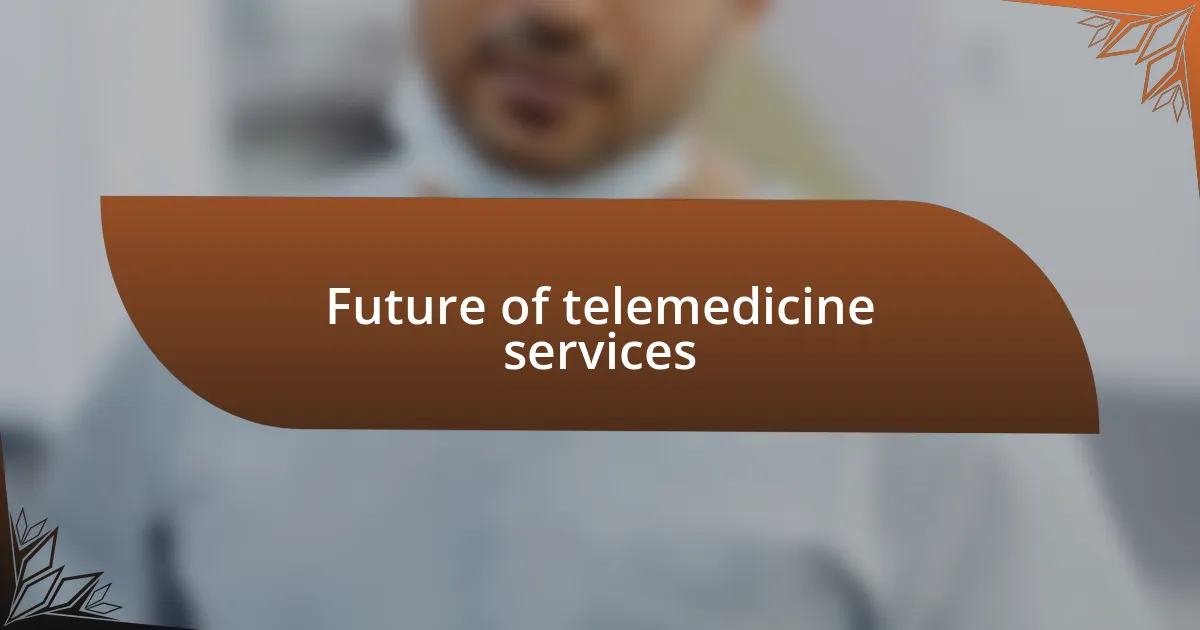
Future of telemedicine services
The future of telemedicine services looks incredibly promising, as the technology continues to evolve at a remarkable pace. I can’t help but feel optimistic about the prospect of more personalized and accessible healthcare. Just think about how far we’ve come—it’s amazing to consider the potential of AI-driven tools to enhance diagnostic accuracy during virtual consultations.
As I reflect on my own experiences, I envision a time when integrating wearables and telehealth will be commonplace. Imagine having a smartwatch that not only tracks your heart rate but also syncs real-time data with your physician during your virtual visit. Wouldn’t it be reassuring to know your doctor has all that crucial information at their fingertips? This could revolutionize patient care and lead to more precise treatment plans tailored to individual needs.
Moreover, I see an exciting shift towards virtual platforms that prioritize mental health services. In my opinion, the stigma around seeking mental health support is starting to fade, and teletherapy plays a key role in that. Picture this: being able to connect with a therapist right from the comfort of your living room. It’s a game-changer that not only enhances convenience but also creates a safe space for vulnerable conversations. How can we not be excited about that evolution in healthcare?


